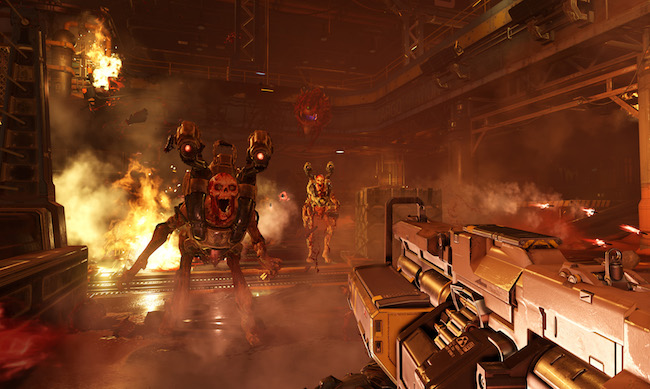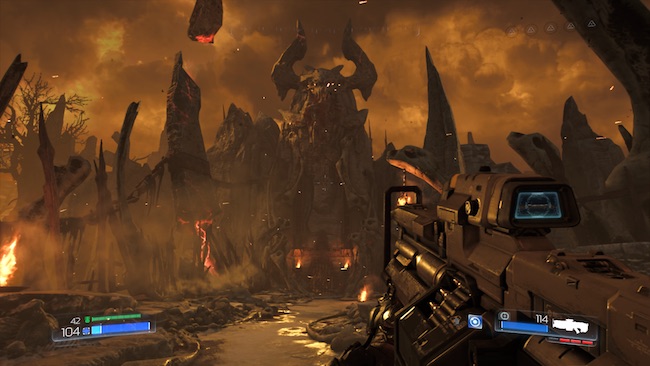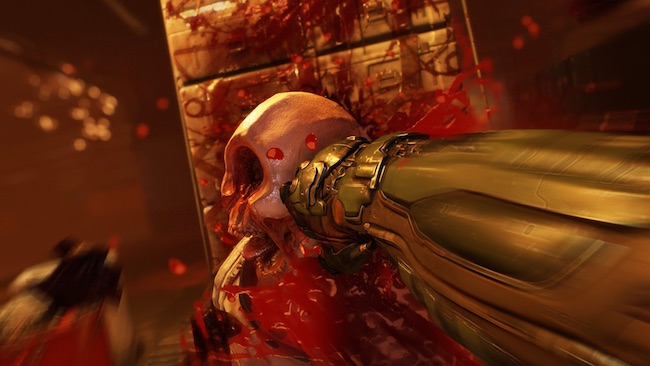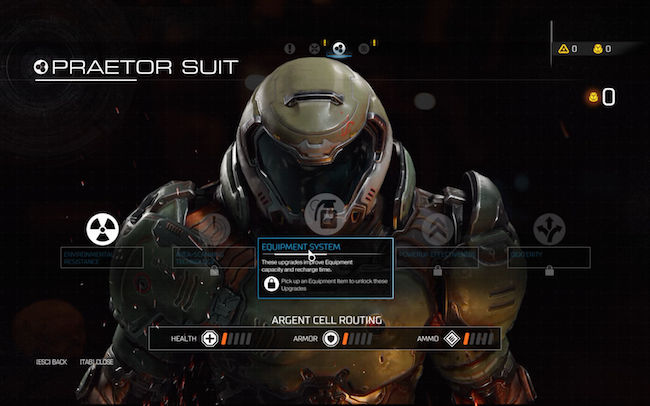
Playing the new DOOM is the video game equivalent to listening to a new album released by your favourite 70s rock band, or a big-budget remake of your favourite childhood film; sure, it’s got the same name, and it’s (mostly) the same dudes doing the same thing that they’ve always done, but there’s an inescapable feeling of numerous unseen forces acting on the product you’re hoping to enjoy; numerous questions start to enter your mind: Why are they doing this album now? Why did the producer write so many of these songs? Is that the same riff they used on that song two albums ago?
The aforementioned tone of experience is largely what I’ve felt playing through DOOM (2016); while it pays due homage on both a philosophical and symbolic level to the original groundbreaking titles, at times this feeling amounts to little more than lip service and leaves the rest of DOOM feeling like its having some kind of identity crisis: it feels like it makes a concerted effort to get back to its classic roots of pumping, fast-paced run and gun action, but cannot escape certain design modernizations that ultimately stagger, or at worst, interrupt the unfolding action. The original DOOM titles felt like a heavy metal album come to life- from the cranking metal cover MIDI soundtrack to gunning down hordes of monsters in an increasingly dark and despairing hellscape left players feeling like they were playing through a Slayer album come to life.

Integral to this point, we have the spirit of DOOM; originally the product of the first rockstars of gaming- a young, ambitious and formidably talented team led by the two Johns. Their most influential work, DOOM set in stone the viability for the PC as a legitmate gaming platform. More importantly, DOOM was a product of outsider culture- an artefact made by a bunch of outcasts who didn’t belong anywhere else in society. Gamers, like the developers were largely the weirdos and outcasts. Flash forward over 20 years later, and the landscape of gaming culture has changed drastically. Gaming is no longer weird and outsiderish. Gaming culture now is celebrated by most strata of society, along with the broader platforms and support for gaming. So what does this major culture shift mean for the DOOM legacy in this brave new world?
Right off the bat, DOOM feels it symbolically pays homage to its legacy, as the nameless marine (unofficially referred to as DOOMguy) literally rises from what looks like an archeologically unearthed stone sarcophagus, going on to unleash his unbridled, hypermasculine fury on the shuffling corpses in the room. Next door to his carnage lies another archaeological find; buried in stone for untold aeons is his pristinely preserved combat armour. It becomes quickly apparent that once again, the DOOMguy we knew and loved is once again on the loose, ready to bring down a torrent of unfathomable brutality on the invading demonic horde.

As in the original DOOM, the graphic violence is elevated to the level of spectacle, and certainly DOOM (2016) treats this element with the utmost respect. Once again, you step into the hefty demon-stomping boots of the original trans-dimensional badass ready to unleash hellish fury on the demonic forces. And DOOM pulls no punches here- you’ll be crunching skulls, tearing guts and blasting monsters into to chunky red salad right from the get go. A lovely little touch was the opening voiceover advising you to ‘rip and tear’- a phrase first spoken in the rather nonsensical DOOM comics from the mid-90s; it returned in the highly popular fanmod ‘Brutal DOOM’ as a switchable berserker mode, but having it appear in the DOOM canon has secured its place in the mythology for all time. There’s odd, subtle traces of the tongue in cheek humour of the original DOOMs, though at times it feels lost in the intensely atmospheric mix you’re wading through.
While the experience starts out promisingly enough, pretty soon DOOM falls into the same linear format that belies most modern FPS design; the sad part though, is that when it tries to open up the world to the player and offer some broader areas to roam around in, the experience feels bogged down in the vast and intricate spatial design; sure, it all looks pretty and there’s areas to explore, but the change of gears feels so muddy that you’re often wandering around large, empty areas for stretches of time and you’ll not see a single monster, only to engage some trigger event and be swarmed once again. This inconsistent pacing feels like something of a consistent sticking point with DOOM (2016) that never irons itself out.

The ‘arena’ segments feel a little too purpose built and predictable, and while earlier sections start out promisingly enough with some more open spaces, pretty quickly the player is funnelled into a one-way linear walk through the environments that feels more like you’re just being shuffled from combat arena to combat arena. It’s fortunate though that the combat happens to be a hell of a lot of fun. I was impressed too that even on my ageing PC hardware, the idTech6 engine still maintained a steady framerate, and even with scaled down settings, still looked visually spectacular. It’s also worth noting the superb sound design that has gone into DOOM (2016); the soundtrack is influenced by the original Bobby Prince score, with a distinctively modern, downtuned, dynamic flair.
DOOM has always been about blood-pumping combat, and DOOM (2016) has gone to great lengths to ensure fast, relentless and downright satisfying gunplay- the weapons feel suitably powerful, and watching the bodies of demons break apart as they take a full double-barrelled blast to the upper torso never lets up in satisfaction. However, my main gripe with combat is the weapon mods system- it feels like an uncharacteristically complex inclusion that winds up grinding the action to a halt. The mods themselves are neat, and add more colour to the otherwise singular-function weapons, though it doesn’t seem entirely rational that their features remain behind the paywall of ingame currency. Maybe the game didn’t necessarily have to give them all to you at once, but you could get them in other ways, such tearing them from the cold, dead fingers of the monsters you’ve just blown apart.

If I want to be really nitpicky, I would critique the absence of certain plot devices in the original DOOM; and the way it tied the original episodes together (being that teleportation experiments inadvertently opened a dimensional gateway to Hell; where DOOMguy apparently ‘dies’ at the conclusion of the first episode, only to awaken on the lost Deimos base, where he discovers it floats above Hell itself). It seems like a great missed opportunity to hearken back to the premise of the original groundbreaker, though that may not be entirely the point of DOOM (2016).
Aesthetically, iD’s choices, while diegetically appropriate feel a little dry- the UAC base retained a consistently mechano-industrial look. While this isn’t necessarily an issue, it felt somewhat at odds with the source material; the original ‘techbase’ design of the Phobos moon base, towards the end of the episode showed subtle signs of demonic infestation as the blight of Hell showed through towards the later levels. Upon his arrival on the Deimos base, seeing the greater merger between the occult-demonic symbols and artefacts and the hi-tech artifacts of the moonbase, only to reach Hell itself and find all manner of arcane, sacrificial altars and demonic architecture all amidst the savage hellscape.

I was both sceptical and excited when I started playing DOOM (2016); the familiar tropes, the setting and the soundtrack were all saturating to the senses and brought both a sense of nostalgia and refreshing sense of revitalisation. Soon afterwards I found myself bogged down in something of a campaign lull/fatigue; after that, as new demon types and weapons emerged, it finally set in for me that DOOM wasn’t just about revisiting the same concepts from yesteryear; it was about creating something new, that hopefully paid due homage to its lineage. It might not be the ground-breaking title of its namesake, but it’s a fast, ferocious, highly produced modern metal album of a game to sink your berserker fists into.











